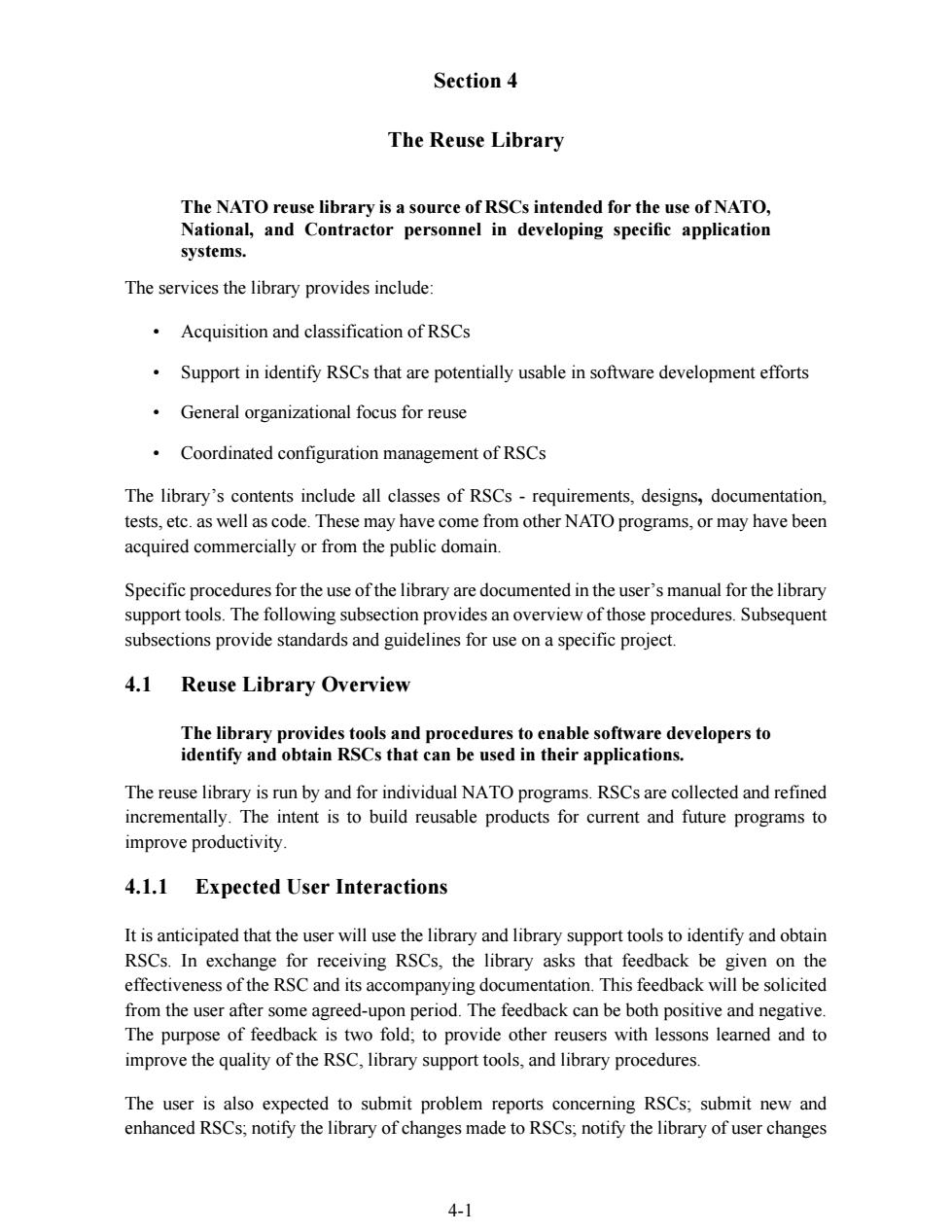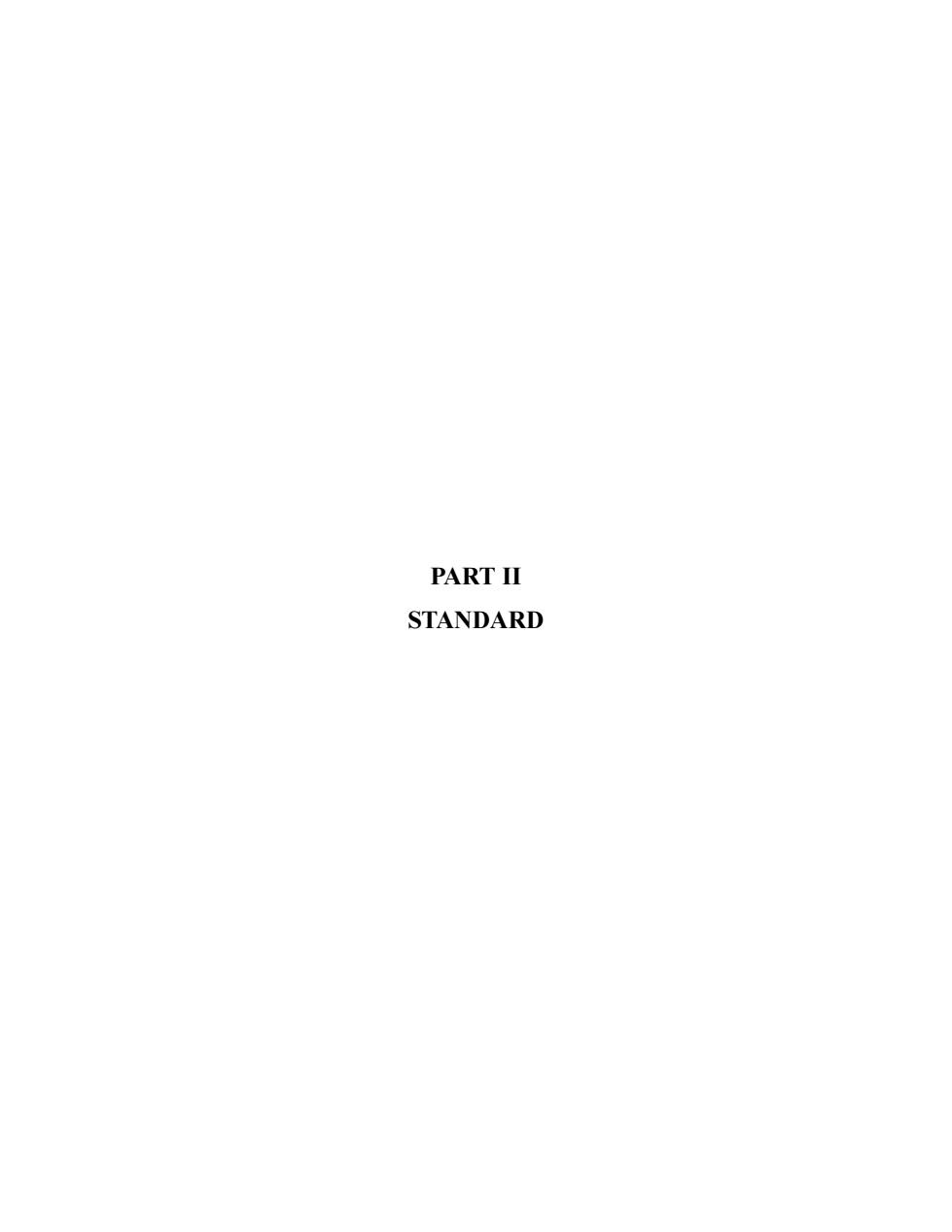
Section 4 The Reuse Library The NATO reuse library is a source of RSCs intended for the use of NATO. National,and Contractor personnel in developing specific application systems. The services the library provides include Acquisition and classification of RSCs Support in identify RSCs that are potentially usable in software development efforts .General organizational focus for reuse Coordinated configuration management of RSCs The library's contents include all classes of RSCs-requirements,designs,documentation. tests,etc.as well as code.These may have come from other NATO programs,or may have been acquired commercially or from the public domain. Specific procedures for the use ofthe library are documented in the user's manual for the librar support tools.The following subsection provides an overview of those procedures.Subsequent subsections provide standards and guidelines for use on a specific project. 4.1 Reuse Library Overview The library provides tools and procedures to enable software developers to identify and obtain RSCs that can be used in their applications. The reuse library is run by and for individual NATO programs.RSCs are collected and refined incrementally.The intent is to build reusable products for current and future programs to improve productivity. 4.1.1 Expected User Interactions It isanticipated the raryand library obain RSCs.In exchange for receiving RSCs,the library asks that feedback be given on the effectiveness of the RSC and its accompanying documentation.This feedback will be solicited from the user after some agreed-upon period.The feedback can be both positive and negative The purpose of feedback is two fold;to provide other reusers with lessons learned and to improve the quality of the RSC,library support tools,and library procedures. The use r is also expected to submit problem concerning RSCs;submit new and enhanced RSCs;notify the library of changes made to RSCs,notify the library of user changes 4-1
4-1 Section 4 The Reuse Library The NATO reuse library is a source of RSCs intended for the use of NATO, National, and Contractor personnel in developing specific application systems. The services the library provides include: • Acquisition and classification of RSCs • Support in identify RSCs that are potentially usable in software development efforts • General organizational focus for reuse • Coordinated configuration management of RSCs The library’s contents include all classes of RSCs - requirements, designs, documentation, tests, etc. as well as code. These may have come from other NATO programs, or may have been acquired commercially or from the public domain. Specific procedures for the use of the library are documented in the user’s manual for the library support tools. The following subsection provides an overview of those procedures. Subsequent subsections provide standards and guidelines for use on a specific project. 4.1 Reuse Library Overview The library provides tools and procedures to enable software developers to identify and obtain RSCs that can be used in their applications. The reuse library is run by and for individual NATO programs. RSCs are collected and refined incrementally. The intent is to build reusable products for current and future programs to improve productivity. 4.1.1 Expected User Interactions It is anticipated that the user will use the library and library support tools to identify and obtain RSCs. In exchange for receiving RSCs, the library asks that feedback be given on the effectiveness of the RSC and its accompanying documentation. This feedback will be solicited from the user after some agreed-upon period. The feedback can be both positive and negative. The purpose of feedback is two fold; to provide other reusers with lessons learned and to improve the quality of the RSC, library support tools, and library procedures. The user is also expected to submit problem reports concerning RSCs; submit new and enhanced RSCs; notify the library of changes made to RSCs; notify the library of user changes

of address,telephone number,and project,and notify the library of point-of-contact changes for supported projects. 4.1.2 RSC Quality Standards The library provides RSCs of the highest quality possible.They have identified a minimum acceptance criteria that the RSC must meet in order to be included in the library.Through a system of incremental refinement,the RSCs are expected to improve through reusers refining documentation,improving test coverage,and resubmitting improved RSCs to the library. 4.1.3 RSC Classification Scheme RSCs are organized in the library according to faceted classification schemes.See the appendix on classification scheme in Standard for Management of a Reusable Software Component Library for more information.When an RSC is first received by the library,the applicable domains for the RSC are identified and the RSC is classified,based on its documentation, according to a domain-specific classification scheme. 4-2
4-2 of address, telephone number, and project; and notify the library of point-of-contact changes for supported projects. 4.1.2 RSC Quality Standards The library provides RSCs of the highest quality possible. They have identified a minimum acceptance criteria that the RSC must meet in order to be included in the library. Through a system of incremental refinement, the RSCs are expected to improve through reusers refining documentation, improving test coverage, and resubmitting improved RSCs to the library. 4.1.3 RSC Classification Scheme RSCs are organized in the library according to faceted classification schemes. See the appendix on classification scheme in Standard for Management of a Reusable Software Component Library for more information. When an RSC is first received by the library, the applicable domains for the RSC are identified and the RSC is classified, based on its documentation, according to a domain-specific classification scheme

PART II STANDARD
PART II STANDARD